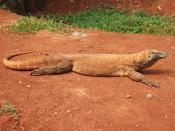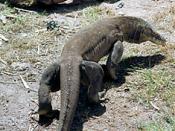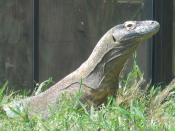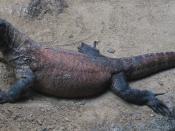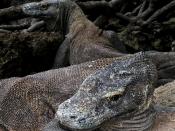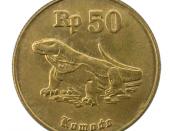THE KOMODO DRAGON English 1302 REFERENCES Darling, Kathy. Komodo Dragon: On Location. Florida: Houghton Mifflin, 1997.
Getz, Phillip W. "Komodo Dragon."ÃÂ Encyclopedia Britannica, 1991 XXX, pg. 945.
Harris, William H. and Judith S. Levy. "Lizard."ÃÂ The New Colombia Encyclopedia, 1975, IV, pg. 1597.
Misrty, Naina. Real Life Dragons. New York: Discovery Channel Magazine, July 1999.
O'Hare, N. K. and G.H. Dalrymple. The Behavior of the Komodo Monitor. Florida: Bulletin of the Museum of Natural History, 1997.
World Book "ÃÂ Child Craft International. "Komodo Dragon."ÃÂ The World Book Encyclopedia, 1980, pg. 289.
1. www.bagheera.com/CLASROOM/casestud/komodo.htm 2. www.oit.itd.umich.edu/projects/adw2k/accounts/varanus 3. www.discovery.com/conv/creature/creature990711/creature.html Dragons. Who'd ever think that today, in the last year of the twentieth century, that we would or could fathom the existence of dragons? Believe it or not actually dragons still exist; not the fire breathing type found in fairy tales, but the forked tongue and scales are still present. There was, however a large dragon in Australia that grew to about 25 ft in length and the Komodo dragon is believed to be related to this dragon.
Though these dragons aren't of the mythical form, they are reptiles that can grow to be 10 feet long and weigh more than 300 pounds. The Varanus Komodoensis, more commonly known as the Komodo dragon is the largest of the monitor lizard, which can be found on Komodo, a small Indonesian island. When a dragon is born it is about 4-6 inches long. An average Komodo dragon grows to about 8 1/2 feet long and between 180-190 lbs. The males are up to 3 times the size of a female. The longest one known of is 10 feet, 3 inches long, weighing 300 lbs. The females average 6 and 1/2 feet long and between 60-80 lbs. The life span is about 30-40 years. The oldest one on record was 37 years old.
These large carnivorous creatures were given the island of Komodo as they were being hunted for their skins and flesh in the early 1900's in order to stop them from becoming extinct. They are protected by the Indonesian government, which has turned the island of Komodo into a national park to preserve their habitat. An estimated 5,000 Komodo dragons live on Komodo and its neighboring islands in Indonesia. Many Easterners found them to be a delicacy; therefore they were hunted in large numbers. Though the Komodo dragon was being hunted it is said that they also were the hunters and that many of the natives of Indonesia had been bitten, yet they lived without any sort of antibiotic treatment. According to scientist Rhoda Bryant, on one of the expeditions, the scientists accidentally ran into a villager who had been bitten by a dragon and had survived without antibiotic treatment. Other than him, there have been a number of people who have been bitten, who have survived with or without antibiotics.
These reptiles have highly deadly bacteria in their mouths can infect and kill large animals, even humans, within a few days of being bitten, allowing the reptiles to consume prey at their convenience. Since 1994, a team of scientists has been studying the Komodo dragons on "ÃÂexpeditionary biology"ÃÂ trips to Indonesia. The scientists are taking blood and tissue samples to determine whether they have antibodies that can be used to treat humans, yet the dragons have been tested and seem to be immune themselves to the bacteria in their saliva. The dragons are being studied due to their apparent immunity to bacteria, to aid in the developing of new antibiotics for humans as the current forms are becoming less effective. So far there have been 62 different kinds of bacteria found in the mouth of the dragon.
There are 30 zoos that have these mysterios creatures in captivity for display and research. Though, many expeditions have been done, their primary function is to develop new antibiotics for humans. In the wild the dragons have not shown any signs of resistance to any antibiotics that were given by the scientists to further develop a knowledgwe of their suspectable resistance to disease. It is thought that the cause of this is due to the isolation they have had from the rest of the world. These may be the last great creature that may have a connection to dinosaurs and dragons and the thought that they may some how aid in the creation of newer technologies for human health may become reality in the near future.
